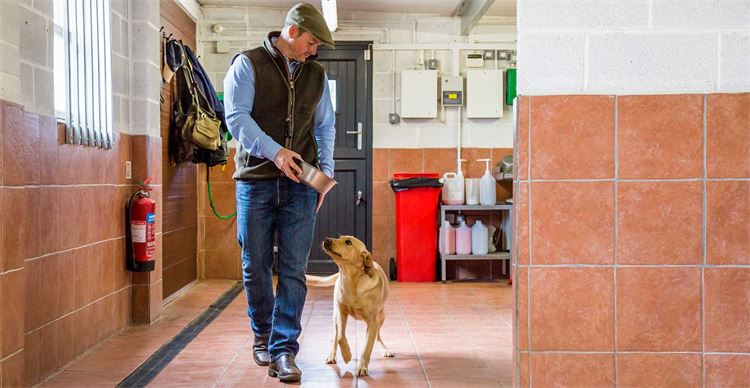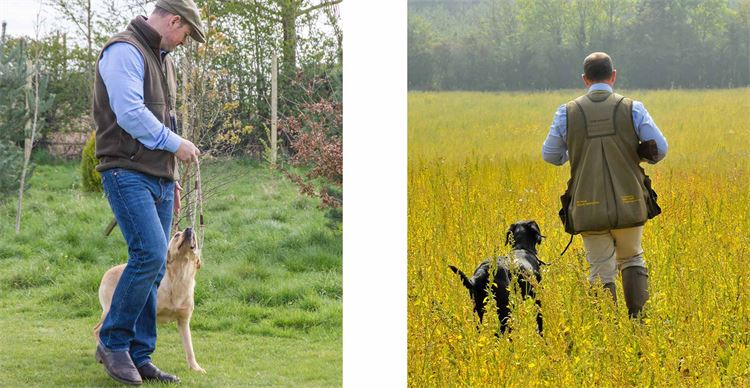Of all the various aspects of gundog training, training a dog to walk to heel properly is one that many people fail to invest the necessary time in. Indeed, some people appear not to see the dog heel command as a priority - hunting, stop whistles, hand signals and retrieving are far more exciting, after all.
But a dog that doesn’t walk to heel can cause problems. While on a lead, your dog is safe, as you know where it is. However, off the lead, a dog that hasn’t been taught to stay by your side will be a liability, and it can be a constant battle to keep it close and out of trouble.
Where To Start With Training A Dog To Heel
The way a dog is taught to walk to heel is key if you are to avoid affecting other areas of its training. Too much nagging, for example - a typical reaction to the symptoms of moving through heelwork training too fast - can knock the drive out of a dog and cause it to be less responsive to your commands.
As a result, many spaniel trainers don’t restrict their dogs too much or expect them to be inch-perfect at heel; much better is the spaniel that will hunt with enthusiasm and respond to voice and whistle than one that lacks any real desire to quarter as a result of over-bearing heelwork sessions.
If your dog is already at the stage where he or she is pulling on the lead and not walking nicely to heel, you will have to be prepared to invest a lot of time (and patience!) to master the dog heel command, but it can be done.
The following advice is written with young dogs in mind, but for an older dog with poor heelwork, I recommend going back to basics and using a very similar routine.
Master The Dog Heel Command Early On
As with all basic training, the foundations are best established with your dog as a pup. You needn’t be rigid with training sessions - they must be fun and stimulating.
I train my puppies at their mealtimes, when all eyes are on me. This also keeps sessions positive. As with all gundog training, I start with very simple exercises that can be built on over time, altering variables, such as the environment, duration, whether the dog is on or off the lead, and distractions, as we go.
A young dog must first be taught the ‘close’ or dog heel command - and the trick is to do this without the dog realising that it is being trained.
If you carry your gun over the crook of your right arm, it makes sense to teach your dog to walk just behind your left knee, and vice versa. With this in mind, you can try the exercises detailed below.

Gundog Training Exercises To Teach A Dog To Heel
1. Follow The Leader
Begin your training in a confined area with no distractions - a hallway or corner of the garden is ideal. Assuming you want the dog to walk on your left, hold a bowl of food in your right hand and calmly walk with the dog off the lead, tapping your left leg with your left hand as you go.
The puppy’s interest in the food will entice him or her to follow you - at the same time, tap your left leg and turn your body so that it faces to the left to encourage the pup to walk on your left, not your right.
Make it easy for the dog at this stage and give gentle praise when they are walking in the desired position.
The key here is to use frequent changes in direction to keep the pup guessing and beside your left knee. Reward success with the food bowl, and keep your training sessions short and positive sessions.
2. The Verbal Dog Heel Command
Only once the pup has grasped the basics of staying roughly beside you when you tap your leg, should the word ‘heel’ be introduced as part of the dog heel command.
Do not overuse the word, but use it each time you change direction. If the dog loses focus, rattle the food bowl and say its name followed by repeating the heel command.
Tips For Training A Dog To Heel In Different Environments
It is a good idea to start changing the location of your gundog training sessions once the dog has mastered the basics of walking to heel off the lead with no distractions. Again, start very simply and progress in small increments.
Fences, walls and other natural barriers can be very useful and force a pup to stay close. By striding into the space in front of the puppy, north-east of your left knee, you are also constantly reiterating that it is your space, and the pup is not to venture into it.
Training A Dog To Heel On The Lead
It might come as a surprise to see this point so far into the article, but I find it best not to rush into introducing the lead when training a dog to heel. First, allow the dog to get a grasp of heelwork off the lead, when it will not be thinking about the strange piece of rope around its neck.
Again, mealtimes offer the perfect opportunity to make the experience a positive one. Use a soft and lightweight slip lead that matches the size of the pup and, to begin with, let the handle of the lead trail loose on the floor while you go about the heelwork exercises outlined above.
Where’s The Best Place For Training A Dog To Walk To Heel?
Until you’ve introduced your dog to the lead, there’s little point in conducting your training sessions in an area where they are likely to get distracted. Indeed, pups have short attention spans, and their curiosity can easily disrupt a training exercise. Once the dog is accustomed to the lead and walking to heel well, it is possible to begin introducing new variables, albeit very gradually.
Of course, the basics will already have been established and the dog knows what ‘heel’ means, which is important; if the pup does not know this, how is he or she to know when they are doing wrong?
Without doubt, heelwork goes hand in hand with steadiness; you will struggle in training a dog to walk to heel well if it cannot control the urge to chase, greet, or investigate things immediately upon seeing them.
Remember to keep the sessions interesting for the dog. Heelwork, of all gundog training exercises, can quickly become tedious and mundane for a young dog. It’s for this reason that from a young age, I incorporate heelwork training into a broader exercise. The interest and stimulation provided by these other gundog training exercises gradually replaces food as an incentive, while bypassing the risk of the dog becoming bored

Gundog Training Exercises For Training A Dog To Heel
Try these gundog training exercises to improve your dog’s grasp of the dog heel command in different scenarios:
1. Removing Food
Once the pup is comfortable with the lead being around its neck, continue with short, basic heelwork sessions in the areas you’ve already been working in, with food in your right hand and the lead in your left, remembering to use body language and changes in direction to encourage the pup to focus on you and stay just behind your left knee.
When you’re confident you can do this for a short while without the dog losing interest, then you can attempt the same but without the food bowl.
Stay calm here, as the pup will probably not be quite so attentive now that the food - its main motivation - has been removed from the equation. If the pup strays to the side or pulls in front, give the lead a short but sharp snap, change direction and give the dog heel command. This grabs the dog’s attention and reminds it to keep an eye on you at all times.
2. Removing The Lead
The lead offers the opportunity to polish heelwork and really work on keeping a gundog close. Once this has been achieved at a basic level, it’s time to transfer these skills to off-lead work too:
- I first hold each end of the lead and place the large loop over the head of the dog, practising what we’ve learnt already in this fashion
- I then simply dangle the lead in front of the dog and walk slowly, all the time ensuring the dog does not stray in front or away to the side
- If the dog is not focused on the task at hand or you are struggling to keep him/her close, it’s likely you have moved on too soon
How To Handle Distractions When Training A Dog To Heel
Only once the dog is attentive on and off the lead in a distraction-free area should distractions be introduced.
A calm, older dog is a good place to start. Simply sit the older dog up and perform your training exercise around him. If the young pup pulls towards the older dog, say ‘leave’, give the lead a short snap and change direction. Work on this gradually over several days and only increase the level of distraction once you feel your dog has mastered each stage in turn.
As you reach the more advanced stages of this gundog training exercise, distractions might take the form of balls and dummies thrown while you are walking with the dog at heel, or livestock, game, and other excitable dogs. Here, any shortfalls in steadiness training will be highlighted. It’s crucial that your dog is ready before being taken into such situations.
Remember, if at any point you feel the exercise is too demanding for the dog, go back to basics and work further on your steadiness exercises - dogs are not robots and need to be taught and shown how to do things.
How To Integrate The Dog Heel Command Into Exercise Sessions
Until now, short heelwork sessions will have been part of the mealtime routine, which also includes basic sit and stay exercises. For some of your sessions, you will have started to use retrieves and recalls as the end incentive as well.
As an example, one might throw a ball or dummy while the dog sits and watches, then walk with the dog at heel away from the ball, before sending the dog back to retrieve it. The dog will only be allowed to retrieve the ball in this instance if it has first walked perfectly to heel.
Vary these exercises too. As other areas of your gundog training advance, stop whistles, directional work, heelwork, and hunting can be incorporated into the same short session.
Tips To Bear In Mind When Training A Dog To Heel
Here are some of the most important points to bear in mind when you’re training a dog to heel:
- Don’t separate heelwork from other exercises - young dogs become bored quickly
- Don’t move too quickly through training stages - too much too soon will inevitably lead to failure further down the line
- Stay consistent - do not allow the dog to pull ahead without consequence
- Try not to resort to using a harness - instead, address the cause of the issue
- Stay patient and keep your cool - training sessions must be positive
- Don’t nag - constantly repeating the dog heel command will make them less responsive
For more advice on gundog training, check out our training and advice hub, or subscribe to Gundog Journal today.